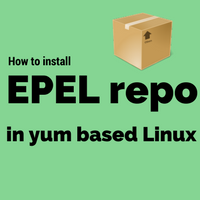Learn how to install EPEL repository (Extra Packages for Enterprise Linux) in YUM based Linux. It enables you to install open source packages.

What is EPEL
EPEL stands for Extra Packages for Enterprise Linux. EPEL repository is helpful and rich with packages that are normally used/needed for commonly used Linux software. This repository is managed by the EPEL group. This repository contains all 100% free open source packages which may not available in the core
EPEL repos should be used in production with extra caution.
As you know EPEL group is the Fedora project, EPEL repository can be enabled for YUM based systems like RHEL, Oracle Linux, Fedora, CentOS, etc distributions.
How to configure EPEL
Adding EPEL repository can take a different route than adding https, FTP repositories in YUM. For EPFL, you need to download related RPM from link using any Linux downloaders. Choose correct distro and architecture while choosing a download link for the EPEL package. Or you can choose noarch rpm as I did below.
I downloaded rpm using wget as below :
# wget https://dl.fedoraproject.org/pub/epel/epel-release-latest-6.noarch.rpm
--2017-04-03 13:18:35-- https://dl.fedoraproject.org/pub/epel/epel-release-latest-6.noarch.rpm
Resolving dl.fedoraproject.org... 209.132.181.25, 209.132.181.23, 209.132.181.24
Connecting to dl.fedoraproject.org|209.132.181.25|:443... connected.
HTTP request sent, awaiting response... 200 OK
Length: 14540 (14K) [application/x-rpm]
Saving to: “epel-release-latest-6.noarch.rpm”
100%[===================================================================================================================>] 14,540 51.5K/s in 0.3s
2017-04-03 13:18:37 (51.5 KB/s) - “epel-release-latest-6.noarch.rpm” saved [14540/14540]
You should have rpm file in your current directory.
# ll
total 680
-rw-r--r--. 1 root root 14540 Nov 5 2012 epel-release-latest-6.noarch.rpm
You need to install rpm using yum command.
# yum install ./epel-release-latest-*.noarch.rpm
Loaded plugins: amazon-id, rhui-lb, security
Setting up Install Process
Examining ./epel-release-latest-6.noarch.rpm: epel-release-6-8.noarch
Marking ./epel-release-latest-6.noarch.rpm to be installed
Resolving Dependencies
--> Running transaction check
---> Package epel-release.noarch 0:6-8 will be installed
--> Finished Dependency Resolution
Dependencies Resolved
=============================================================================================================================================================
Package Arch Version Repository Size
=============================================================================================================================================================
Installing:
epel-release noarch 6-8 /epel-release-latest-6.noarch 22 k
Transaction Summary
=============================================================================================================================================================
Install 1 Package(s)
Total size: 22 k
Installed size: 22 k
Is this ok [y/N]: y
Downloading Packages:
Running rpm_check_debug
Running Transaction Test
Transaction Test Succeeded
Running Transaction
Installing : epel-release-6-8.noarch 1/1
Verifying : epel-release-6-8.noarch 1/1
Installed:
epel-release.noarch 0:6-8
Complete!
Thats it. EPEL repository is accommodated by your YUM configuration now.
EPEL repository test
Let’s test the EPEL repository if it’s configured properly. You should see below the new repo in directory /etc/yum.repos.d This is the first indication EPEL is configured.
# pwd
/etc/yum.repos.d
# ll
total 32
-rw-r--r--. 1 root root 957 Nov 4 2012 epel.repo
-rw-r--r--. 1 root root 1056 Nov 4 2012 epel-testing.repo
Now extract repolist from yum to verify configuration.
# yum repolist
Loaded plugins: amazon-id, rhui-lb, security
repo id repo name status
epel Extra Packages for Enterprise Linux 6 - x86_64 12,361
rhui-REGION-client-config-server-6 Red Hat Update Infrastructure 2.0 Client Configuration Server 6 0
rhui-REGION-rhel-server-releases Red Hat Enterprise Linux Server 6 (RPMs) 19,422
rhui-REGION-rhel-server-releases-optional Red Hat Enterprise Linux Server 6 Optional (RPMs) 11,057
rhui-REGION-rhel-server-rh-common Red Hat Enterprise Linux Server 6 RH Common (RPMs) 129
repolist: 48,031
You can see EPEL is configured and identified properly by YUM (highlighted line).
Share Your Comments & Feedback: